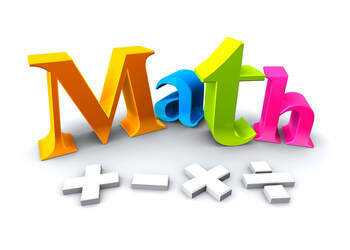+ - x ÷ =
 Can you imagine doing math before math symbols were created? Imagine if you had to write out, “Five multiplied by six is equal to thirty” or “Forty-eight divided by four is equal to twelve” every time you sat down to do your math homework.
Can you imagine doing math before math symbols were created? Imagine if you had to write out, “Five multiplied by six is equal to thirty” or “Forty-eight divided by four is equal to twelve” every time you sat down to do your math homework.Thank goodness someone invented some shortcuts. Now you can just write, 5 x 6 = 30, or 48 ÷ 4 = 12. Think of the savings in time and ink.
Where do these mathematical symbols come from?
+ Plus
The plus sign is a short version of Latin et (and); i.e., the ‘t’ in et becomes +. This symbol was first used in the mid-14th century by the French mathematician Nicolas d’Oresme (1323 – 1382).
In ancient Egyptian hieroglyphics, plus was indicated by a pair of feet walking in the direction in which a document was read; minus was indicated by a pair of feet walking backwards toward what had already been read.
— Minus
The minus sign was developed in 1494 by the Italian mathematician Luca Pacioli (1445 – 1517).
x Multiply
The multiplication sign ‘x’ was developed and popularized by the English mathematician William Oughtred (1574 – 1660). He also invented the slide rule. Some think a dot ● should have been used instead of ‘x’ because possible confusion with x = multiply, the x in x2 + y2 = z2, ‘x marks the spot’, ‘x as the unknown factor’, and so on. However, like any good meme, the ‘x’ sign for multiplication has won the day.
÷ Divide
The ÷ symbol for divide is called an obelus, the Greek word for a pointed stick. The first use of the sign is credited to the Swiss mathematician Johann Rahn (1622 – 1676) who first used it in 1659.
= Equal
The equal sign was invented by the English mathematician Robert Recorde (d. 1558).
What were the equivalent symbols used by the Islamic mathematicians of the early Middle East and South Asia long before the ‘+ - x ÷ =’ symbols were invented by the medieval European mathematicians? Sounds like another research project.
Reference: Online Etymological Dictionary, https://www.etymonline.com/
https://encyclopediaofmath.org/wiki/Mathematical_symbols
https://www.scienceabc.com/pure-sciences/start-using-math-symbols
https://www.huffpost.com/entry/where-and-when-did-the-sy_b_2860100
Published on May 20, 2022 18:05
No comments have been added yet.



